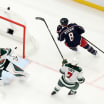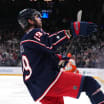This week, BlueJackets.com is taking a look at a few ways in which the game of hockey is changing right before our eyes. From a game that's getting faster by the second to one increasingly impacted by analytics off the ice, the NHL and the Blue Jackets are in the midst of an age of rapid transition. This week's stories will take a look at those trends across the league and how the Blue Jackets are staying at the forefront of all that is going on.
When Jim Corsi went to talk about a job opportunity with the New Jersey Devils a quarter century ago, the goaltending guru found he had an immediate differing of perspectives with the head coach he was interviewing with.
"I interviewed with Jacques Lemaire 25 years ago for a job," Corsi recently told BlueJackets.com. "I said, 'You have to be able to make the save, you have to be able to get your feet under you and get to the next play.'
"He said, 'For me, I don't care. Make the first save and then we'll take care of the rebound.' That was it.
"That has now changed."
The Changing NHL: For goalies, a faster game means more to do
Today's netminders face new challenges in a league with such young talent

© Jamie Sabau
Fair or not, Lemaire's name is in many ways now synonymous with the defensive-minded style of the mid-1990s that turned hockey into a slugfest. It was also enormously successful, as the Devils won the Stanley Cup in 1995 amid a consistent run of postseason appearances.
But the comment speaks to a philosophy that flourished as the much-rued "clutching and grabbing" era took hold in the '90s and 2000s. With defensive players allowed to tie up opposing forwards as they crashed the net, goalies often just had to make the first save and let their defensemen do the rest.
THE CHANGING NHL: Speed kills
It's among the many reasons save percentages skyrocketed in the mid-1990s, jumping above .900 in 1994-95 for the first time in 23 seasons. In addition, as styles changed, goalies simply got better and the position became more refined. The save percentage would top .910 for the first time in 2003-04 and has settled in north of that mark every year since 2009-10.
But there are signs things are starting to change. The combination of a faster game, a bevy of young talented goal scorers, streamlined goalie equipment and offensive strategies based on getting pucks to the blue paint from any and all angles has led the league-wide save percentage to go from .915 three seasons ago to .910 last year.
Corsi, who was hired last summer as the Blue Jackets goaltending development coach and works with the young goalies throughout the organization, sees an NHL now where goaltenders have to possess a much more varied set of skills than they did 25 years ago. Chief among them is the athleticism the former NHL goaltender and longtime coach has wanted his pupils to have.
"A large part of it is the way the game has evolved right now is that they need more athleticism because of the nature of the game," said Corsi, who is joined among goalie coaches in the CBJ organization by Manny Legace and newly hired European development coach Niklas Backstrom. "It's no longer clutch and grab, the battle in front of the net, all that type of stuff. The puck can move more readily, more and more players are skilled, and it's more and more congested (in front).
"The original play may not be the dangerous play, so goaltenders not only have to affect a skill in covering the net to make a save because of a situation that occurred, but they have to be able to move from that area to another with control."
One area that Corsi, who was previously the goaltending coach for nearly two decades with both the Buffalo Sabres and then the St. Louis Blues, thus stresses is that goaltenders must be able to diagnose what is real and what is a threat.
That doesn't always mean the person with the puck, then, is the person whom the goalie needs to be most aware of.
"I do that, it's part of an exercise -- 'Here's the play, who is dangerous? Here's the penalty kill, where is the danger coming from? You see this guy is right-handed, he's set up for a one-timer, do you notice that? Can he get the puck, can he not get the puck?' " Corsi said.
Opposing offensive players are also not afraid to throw the puck on net from difficult angles as well, leading to an overall feeling of chaos for goaltenders. Sharp-angle shots -- and goals -- have been on the rise as forwards continued to learn that being on the post requires a difficult combination for goalies who must guard against those soft goals from down low but also be able to move across the ice in a flash.
"A lot of sharp angles," Corsi said. "That first shot, that's not the problem. It's what happens after is what everyone is struggling with. What you want to do is be as efficient and as athletic as possible. You make that save, the calamity ends up in the corner, you have to get to the posts. The post is just (right) here, but you have to do that in a controlled fashion. You can't just throw furniture out there anymore."
A bevy of techniques have come up over the years in different fashions help goaltenders deal with such shots. Dominik Hasek popularized the VH (vertical horizonal) method of playing such chances in which his front-side pad would be placed vertically against the post with his back leg horizontal to the ice.
Over the past few years, the reverse VH has taken off, with the front-side pad down horizontally on the ice and the body positioned over it to take away the options along the post while still allowing the goalie to push off when he needs to.
Then there's Tuukka Rask, the Boston goalie who places his shin along the post in such sharp-angle situations. Corsi also recalls teaching a strategy at the NHL Coaches Association clinic used by Sergei Bobrovsky in which the former Blue Jackets goaltender would use the reverse VH but keep his shoulder forward and glove up to take away the angle on shooters.
This is all to say there's a lot that goes into just one aspect of the craft, but much of it boils back to the fundamentals -- having the athleticism and intelligence to stay square to shooters, diagnosing where the danger on the ice is located, and then selecting the save that minimizes danger.
It's all easier said than done, but that's why the position is so much fun, at least in the eyes of Corsi.
"If you want to improve, you always have to have some kind of discomfort, and the most valuable thing that I appreciate in goaltenders is hard work, and after that, curiosity in their craft," Corsi said. "If you're stopping pucks and you only stop pucks, you're doomed to stopping pucks because this guy is going to figure it out and he's going to move it somewhere else, and then now what?"
















